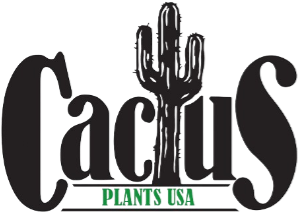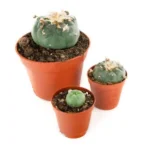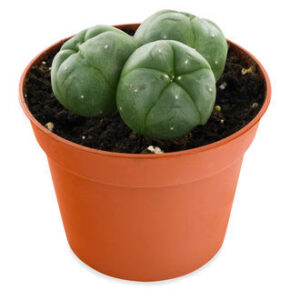Peyote (Lophophora Williamsii)
The Nahuatl word Peyote (Lophophora Williamsii) inspired the Spanish to name the demonic plant peyote. It’s a little cactus with fuzzy tufts instead of spines that seldom climbs more than 3–4 cm above the soil surface, with its lengthy subterranean taproot being the most prominent feature.
Peyote (Lophophora Williamsii) is endemic to southern Texas and Mexico, where it grows in scrubby deserts with a preference for limestone soil. It is being over-harvested in Texas, and its habitat is progressively being utilized for ranching, to the point that peyote is designated as an endangered species. Peyote grows extremely slowly, which makes this situation worse. However, cultivated varieties grow faster; mature, blooming, and harvestable adult cacti (about 3 inches in diameter) take less than three years to develop from seed.
Peyote (Lophophora Williamsii)
Only in the 1900s, with the founding of the Native American Church and legal protection for peyote rites, did peyote openly raise its hallucinogenic head again. In 1953, Aldous Huxley experimented with mescaline under the guidance of Dr. Humphrey Osmond, noting, “This is how one ought to see how things really are. “The next year, Huxley released his famous Doors of Perception, which detailed his mescaline experiences.
PEYOTE INGREDIENTS
Peyote (Lophophora Williamsii) is just another of nature’s amazing chemical factories, producing over 50 alkaloids. The most intriguing of them is the potent entheogen mescaline, which accounts for roughly 0.3% of the fresh cactus and 1-2% of the dried cactus.
PEYOTE CARE & DOSAGE
The cactus’s above-ground portion generates disc-shaped “buttons” that may be cut off.Four to twelve buttons are chopped and eaten, either fresh or dried, or turned into tea.
Buttons should be cut off at ground level or slightly higher to allow new ones to develop.New roots will emerge from the cut base of your cactus if you re-root it in a porous, sandy soil or vermiculite/perlite mix and water it frequently (allowing it to dry out between soakings).
Peyote (Lophophora Williamsii) is exceedingly bitter, and most users experience nausea before experiencing psychedelic effects. Try not to eat anything for at least 6 hours; this will allow you to keep the buttons or tea down for a longer period of time and extract more mescaline before you (inevitably) empty your stomach. Once drunk, your body temperature and heart rate will most likely increase, resulting in perspiration and flushed skin. Stay cool; this is typical.
All usual psychedelic advice applies (excellent set and environment, significance of an experienced guide or sitter if this is your first time, don’t combine with other medications or alcohol, etc.).Finally, believe in the authenticity of your experience and strive to incorporate what you learn into your daily life. Peyote is a highly unique ‘helper’ herb that should not be treated lightly.









Reviews
There are no reviews yet.